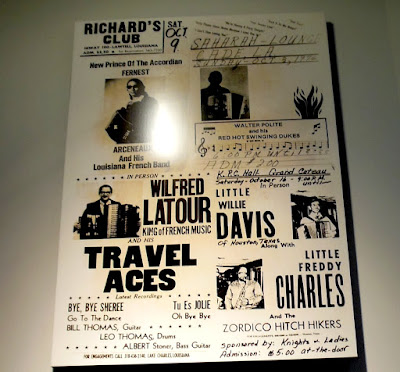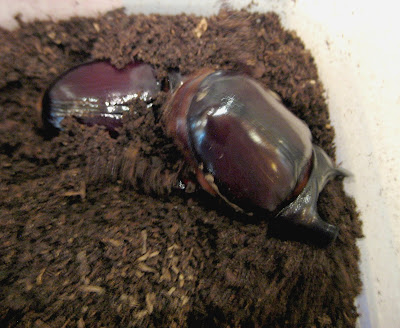 |
| Louisiana Road 3083 |
My biases
1. Budget
This is a series about
budget road trips. Therefore, the recommendations reflect same.
2. New not always better
A new technology
might be better than the old. And it might not be. Its value depends on the user's wants and needs, in addition to the road trip route and a reasonable risk management plan.
A new technology can actually result in an unintended consequence of engendering a
false sense of security, which - at worst - can result in a trip disaster.
3. Hidden costs
Every piece of equipment
carries a cost in regard to:
- Safe-keeping from theft (think big-ass camera)
- Protection from damage (think sizzling summer heat inside a parked car while you go for a hike)
- Worry about forgetting it somewhere (motel room, hanging on restaurant chair, on a restroom counter)
- Practical portage (how much gear do you want to carry on your shoulder, around your neck, or in your pockets?)
- Freedom to be spontaneous (Wow! A street festival! Let's stop! Wait. What about our stuff?)
4. The joys of being out of touch
Some simple joys of a road trip are:
You deny yourself these pleasures if you tether yourself too closely to technology, including social media, texting, and phone calls.
 |
| Mule deer crossing, Bosque del Apache road, New Mexico. |
Technical gear recommendations
Into this category, I place:
- Cameras
- Phones (smart and dumb)
- Laptops, tablets
- Dedicated devices for listening or reading
Cameras
Do you have a big expensive camera? If yes, think carefully about the pros and cons of taking it with you on a road trip.
Decision variables include:
- What are the expected temperatures on your route - will it be too hot to leave the camera in your car for several hours while you do something without the camera?
- How anxious do you get about theft - will you worry too much about leaving the camera in your car on occasion?
- How will the camera - if you have it on your person - affect your freedom of physical movement if you go on a hike, go dancing, walk through a museum, visit an amusement park, walk to the hot springs for a dip, attend a crowded festival?
- What do you generally do with your photos? Post them on social media? Scan through them and then toss the SD card in a drawer? Produce creative work for personal or professional satisfaction?
- Do you feel confident about how to use your big, expensive camera?
- Is photography a major component of your road trip or is it a visual footnote of your trek?
- What are the photographic subjects you're likely to encounter on your road trip? Jaw-dropping scenery that you will stop to contemplate? Micro-beauty such as flowers or insects? Or mostly fun shots of people, places, and things you come across to document your trip?
- Depending on the answers above, is your phone camera good enough for your needs? Do you have an inexpensive point-and-shoot that you could take with you?
Phones
Dumbphones
Do you still only have a dumbphone? No big deal.
If you want a mapping application, then you can buy a dedicated GPS device, although this is a financial investment that may not be worthwhile. Better to borrow a device, if possible. Or maybe you're bringing a tablet with you, and you can use that for your mapping.
But my experience is that a paper map works just fine. Plot out the trip's (or just a day's) route in advance and mark the route with a bright highlighter marker.
A mapping application is most useful when I'm looking for a particular address within a city, and when push comes to shove, I can call the destination point for directions.
Smart phones
- See Road Trip Apps below.
- Consider taking a spare charging cord and keeping it in your trunk, in the event you leave one behind in a motel room.
- If you don't use a pass code to access your phone data at home, think about using one while you're on your road trip. When we're outside our familiar surroundings and routines, some of us get more alert, while others of us get fuzzier. If you fall in the latter camp, then you are more vulnerable to leaving your smart phone behind in your motel room or at a restaurant.
- Consider enabling the emergency alert feature on your phone, if it isn't already. You never know.
- Be a fanatic about charging your phone. If you've got the ability (see Power Recommendations below), think about keeping your phone plugged in while driving.
Laptops, tablets
On a road trip, I do take my laptop. I've weighed the pros and cons and decided that having my laptop with me maximizes my enjoyment of a road trip.
But many folks are extremely comfortable conducting all of their online activities on their smart phones. They may have cameras with wifi capability that allows them to upload photos to their preferred internet destination.
As with the camera variables, think through if you really want to bring a laptop or tablet on your road trip. Remember that every piece of equipment you bring adds to your protection and portability "cost."
Dedicated devices for listening or reading
Currently, I diversify my gadgetry portfolio by having an mp3 player for my music and a basic Kindle for my electronic books. I bring both on road trips.
Dedicated device pros:
- I don't drain my smart phone's juice when I play music or read an e-book
- My mp3 player and Kindle have long battery lives
- Arguably, I enjoy better sound via my mp3 player
- It's easier to read ebooks on my Kindle than on my phone
- I just feel generally better when I diversify my limited resources across several devices
Cons:
- The more gadgets I take on a road trip, the more I have to babysit
- If I've got limited charging capacity in my car, then I've got to be assiduous about charging the devices at night when I've got access to wired resources
- The assumption about better sound on my mp3 player is untested; it is possible the sound is just as good on my phone
- Although I don't want to read an ebook on my phone, I could choose an audio book instead and listen to that on my phone
 |
| Highway 54 train between Corona and Vaughn, New Mexico. 2013. |
Power recommendations
Three-prong to two-prong plug converter
You never know when your overnight accommodations will lack accessible three-prong wall outlets. A converter costs less than a dollar, doesn't take up much space, and you can find one at any big box store.
Surge protector power strip
Whether you're staying in a motel, at a friend's house, an airbnb or a couchsurfing place - outlets can be scarce. If you've got a travel companion, this could double your demand for outlet access. If you don't travel all that much, just bring a power strip from home. Throw it in your trunk and only bring it out if needed.
If you decide to buy a strip:
- Check for roominess between the plug slots. It's annoying to have three or four plug slots on a strip, but the slots are so close together you can't actually fit two plugs right next to each other if one of the plugs is fat.
- Consider cord length. My power strip is designed as travel-friendly (with universal plug slots), so its cord is only ~ 13". This is great for packing, but sometimes it presents minor challenges in a motel room where the only available outlet is hard to reach. This writer uses this travel-size power strip. It has no cord at all.
- If you don't travel much, then a longer cord might be more practical for you. In that case, choose a power strip that you'll like using at home so you don't add to your special-occasion clutter load.
USB wall charger
I've used
this one for several years, and it's worked well for me. I like the blue light that glows while mine is in use because I'm less
likely to forget it in a motel room. I also like the foldable plug. I
can plug the charger directly into a wall outlet or into my power strip.
In the latter, however, it falls into the category of a fat plug, so
this sometimes affects my ability to plug in neighbors.
If I were to buy one today, I'd get one with two USB ports like
this one.
Car lighter adapters
OK, yes, today's cars have handy USB ports and outlets stashed all over the place. If you have such amenities, then skip ahead.
My car is 20 years old, so I've got one power source for charging and playing music: My lighter.
I do have two lighter-based powering gadgets, but they are geezers.
One is a big, heavy, one-outlet power inverter that I bought back in 1990 maybe. I bought it for the road trip to Alaska I took with my daughter.
Upside: It still works. Downside: It's big, it's clunky; it has only one plug-in. I have to use my USB adapter to charge devices on it. And while I'm charging something on it, I can't listen to my music player because I've only got the one lighter and the one port.
My other gadget is a Gigaware FM transmitter device to plug into my mp3 player. It's been a wonderful tool for me on road trips. In the past year, however, I have to place the player in just the right position to get the appropriate volume, so it's on its way out.
When I replace the above two devices, I'll get an
FM transmitter that also has a USB port. This one, perhaps. Consequently, I'll be able to listen to my playlist and also charge my phone. Evidently, such a device would allow me to talk on the phone hands-free if I receive a call. Nice, if true.
 |
| Pearl Street Mall, Boulder, Colorado. |
Road trip apps
I offer my recommendations below. Manage your expectations. It is a humble list.
Road trip planning and management
Evernote is a well-designed application that you and any road-trip companions can use like a file cabinet. Toss into Evernote screenshots, websites, photos, articles, lists, links - a repository of information that helps you plan and manage your trip.
Here is a list of articles about how to use Evernote for a road trip. Set it up on your desktop, laptop or tablet, and sync it to your phone.
Directions
I use Google maps.
Gas price app
I'm trying out
Gas Guru. It seems straightforward.
Gas Buddy is more popular, but seems to have too much interaction.
Road attractions
Roadside America has an app that looks very cool. Alas, it is only for iphones or ipads.
Related links:
Updated: Taking a Budget Road Trip, Part 5: Loose Ends
Updated: Taking a Budget Road Trip, Part 4: Pack List
Updated: Taking a Budget Road Trip: Part 3: Food and Drink
Updated: Taking a Budget Road Trip: Part 2: Lodging
Updated: Taking a Budget Road Trip: Part 1: The Basics
Or click on the
Take a Road Trip tab at the top of this blog. Or click
here.





































